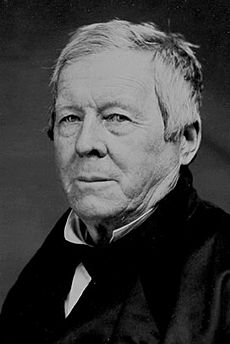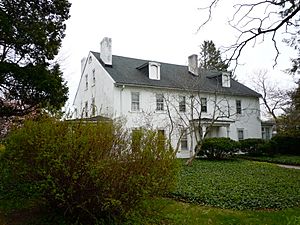Thomas Garrett facts for kids
Quick facts for kids
Thomas Garrett
|
|
|---|---|

Garrett around 1850
|
|
| Born | August 21, 1789 |
| Died | January 25, 1871 (aged 81) Wilmington, Delaware, U.S.
|
| Occupation | Abolitionist, Underground Railroad station master |
| Years active | 1813–1865 |
Thomas Garrett (born August 21, 1789 – died January 25, 1871) was an American abolitionist. He was a very important leader in the Underground Railroad movement before the American Civil War. He helped more than 2,500 African Americans escape slavery.
Because of his work, he faced threats and attacks. There was even a $10,000 reward offered for his capture. He was arrested and found guilty for helping Emeline and Samuel Hawkins escape slavery.
Contents
Thomas Garrett's Early Life
Thomas Garrett was born on August 21, 1789, in Upper Darby, Pennsylvania. This town is just outside Philadelphia. His parents were Sarah Price and Thomas Garrett. His family were Quakers, a religious group known for their peaceful beliefs. They lived on a farm called Riverview Farm.
In 1813, Thomas Garrett married Mary Sharpless. They had five children together. In 1822, he moved to Wilmington, Delaware. He joined the Wilmington Quaker Meeting. Wilmington was a good place for his business because it was growing. It was also perfect for his Underground Railroad work. This was because it was the last city in a slave state before reaching Philadelphia, which was a free state. He set up a safe house, called a "station," in his home at 227 Shipley Street.
Mary, his first wife, passed away in 1828. In 1830, he married Rachel Mendenhall. They had one son. His childhood home, "Thornfield," built around 1800, is still a private home today in Drexel Hill.
Thomas Garrett's Business Career
Thomas Garrett started a business selling iron and hardware. He made it very successful. In 1835, he became a director of the new Wilmington Gas Company. This company made gas for lighting lamps. He also invested in other businesses, like the Principio Furnace in Maryland.
Fighting Against Slavery
Thomas Garrett's work as an abolitionist began in 1813. He was 24 years old. A free Black woman who worked for his family was kidnapped by slave traders. They wanted to sell her into slavery far away. Thomas Garrett rescued her. From that day on, he decided to protect African Americans for the rest of his life.
Quaker Beliefs and Abolitionism
Thomas Garrett was a Quaker. Quakers believed that all people are equal. This belief strongly influenced his fight against slavery. He moved to Wilmington to focus on his work against slavery. In 1827, he helped restart the Delaware Abolition Society. This group worked to end slavery.
He greatly admired William Lloyd Garrison, another famous abolitionist. Garrison visited him once. They both wanted to end slavery, but they had different ideas about how to do it. Garrison believed in non-violence, even if attacked. Garrett, however, believed that slavery might only end through a war. He would defend himself if attacked.
Thomas Garrett was the inspiration for a character in the famous book Uncle Tom’s Cabin. The author, Harriet Beecher Stowe, created the character Simeon Halliday based on Garrett. Like Garrett, Simeon was brave. He was not afraid of getting fined or going to jail for helping people escape slavery.
Working on the Underground Railroad
Thomas Garrett openly worked as a "stationmaster" on the Underground Railroad in Delaware. He worked with William Still in Philadelphia and John Hunn in Delaware. A stationmaster provided safe places, food, and help for people escaping slavery. He helped many people, including the family of Henry Highland Garnet.
Because he was so open about his work, Garrett did not need secret rooms in his house. The authorities knew what he was doing, but he was never arrested for it.
Garrett was also a good friend to Harriet Tubman. She was a famous conductor on the Underground Railroad. She passed through his station many times. Garrett often gave her money and shoes to help her continue her missions. He also helped Tubman's parents escape from the South.
Thomas Garrett said he helped "only 2,700" people escape slavery before the Civil War ended it.
Trial for Helping Slaves Escape
In 1848, Thomas Garrett and another Quaker, John Hunn, were sued in court. They had helped the Emeline and Samuel Hawkins family of seven escape slavery. The two slave owners sued Garrett and Hunn.
The trial took place in the New Castle Court House. Garrett and Hunn were found guilty of breaking the Fugitive Slave Act. This law made it illegal to help slaves escape. Garrett was ordered to pay a large fine of $4,500, which was later lowered to $1,500. This fine was so big that it almost ruined him financially.
But Thomas Garrett stood up in court and bravely said, "Judge, you have left me not a dollar, but I wish to say to you and to all in this courtroom that if anyone knows a fugitive who wants a shelter and a friend, send him to Thomas Garrett and he will befriend him."
Even though a lien was placed on his house, and his friend Hunn lost his home, Garrett kept his business going with help from friends. He continued helping runaway slaves find freedom. By 1855, even more people were coming through his station.
During the American Civil War
During the American Civil War, free African Americans in Wilmington guarded Thomas Garrett's house. After the war, the 15th Amendment was passed. This law gave Black men the right to vote. To celebrate, the African Americans of Wilmington carried Thomas Garrett through the streets. They put a sign on his carriage that said: "Our Moses." This showed how much they respected him, comparing him to Moses who led his people to freedom.
Thomas Garrett's Death
Thomas Garrett died in Wilmington on January 25, 1871. He was buried at the Quaker Meeting House in Wilmington. Freed Black people carried his coffin on their shoulders to his burial place.
Thomas Garrett's Legacy
- In 1993, Wilmington named Tubman-Garrett Riverfront Park after Thomas Garrett and Harriet Tubman. This honors their work on the Underground Railroad.
- Historical markers have been placed in Pennsylvania and Delaware. These markers show important places connected to Thomas Garrett.
- His childhood home, Thornfield, is still a private residence today.
See also


